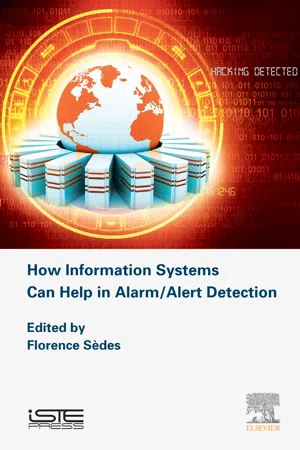
- 280 pages
- English
- ePUB (mobile friendly)
- Available on iOS & Android
How Information Systems Can Help in Alarm/Alert Detection
About this book
Alarm or alert detection remains an issue in various areas from nature, i.e. flooding, animals or earthquake, to software systems. Liveness, dynamicity, reactivity of alarm systems: how to ensure the warning information reach the right destination at the right moment and in the right location, still being relevant for the recipient, in spite of the various and successive filters of confidentiality, privacy, firewall policies, etc.? Also relevant in this context are to technical contingency issues: material failure, defect of connection, break of channels, independence of information routes and sources? Alarms with crowd media, (mis)information vs. rumours: how to make the distinction?The prediction of natural disasters (floods, avalanches, etc.), health surveillance (affectionate fevers of cattle, pollution by pesticides, etc.), air, sea and land transport, or space surveillance to prevent Risks of collisions between orbital objects involve more and more actors within Information Systems, one of whose purposes is the dissemination of alerts. By expanding the capabilities and functionality of such national or international systems, social networks are playing a growing role in dissemination and sharing, eg. with the support of systems like the Google Alert (https://www.google.fr/alerts) which concerns the publication of contents online. Recently, the Twitter microblogging platform announced a broadcast service, designed to help government organizations with alerts to the public. The proper functioning of such systems depends on fundamental properties such as resilience, liveliness and responsiveness: any alert must absolutely reach the right recipient at the right time and in the right place, while remaining relevant to him, despite the various constraints. on the one hand to external events, such as hardware failures, connection faults, breaks in communication channels, on the other hand to confidentiality, such as the collection and use of personal data (with or without the consent of the user), or the disparity of access policies (generation according to industrial, technological, security constraints, management of internal / external policies, etc.) between actors. This book opens the discussion on the "procrastination", the dynamics and the reactivity of the alert systems, but also the problems of confidentiality, filtering of information, and the means of distinguishing information and rumor.- Presents alarm or alert detection in all its aspects- Finds a solution so that the alert information reaches the right destination- Find relevance to various technical issues
Frequently asked questions
- Essential is ideal for learners and professionals who enjoy exploring a wide range of subjects. Access the Essential Library with 800,000+ trusted titles and best-sellers across business, personal growth, and the humanities. Includes unlimited reading time and Standard Read Aloud voice.
- Complete: Perfect for advanced learners and researchers needing full, unrestricted access. Unlock 1.4M+ books across hundreds of subjects, including academic and specialized titles. The Complete Plan also includes advanced features like Premium Read Aloud and Research Assistant.
Please note we cannot support devices running on iOS 13 and Android 7 or earlier. Learn more about using the app.
Information
Predicting Alarms through Big Data Analytics: Feedback from Industry Pilots
Abstract
Keywords
1.1 Introduction


1.2 Background: alarm terminology, system analysis and data analytics
1.2.1 Terminology for alarm types and processing strategies
- – for system maintenance, the standard ISO/IEC 16350 defines different maintenance types (illustrated in Figure 1.3) [ISO 15];

Figure 1.3 Overview of ISO16350 standard for IT maintenance - – for IT services, the Information Technology Infrastructure Library (ITIL) is widely used [OFF 11];
- – in the broader area of business continuity management, many reference frameworks have been published [HIL 10] and standardized [ISO 12], including for SMEs [ENI 10].
Table of contents
- Cover image
- Title page
- Table of Contents
- Copyright
- Introduction
- 1: Predicting Alarms through Big Data Analytics: Feedback from Industry Pilots
- 2: Mobility and Prediction: an Asset for Crisis Management
- 3: Smartphone Applications: a Means to Promote Emergency Management in France?
- 4: Mobiquitous Systems Applied to Earthquake Monitoring: the SISMAPP Project
- 5: Information Systems for Supporting Strategic Decisions and Alerts in Pharmacovigilance
- 6: An Ontologically-based Trajectory Modeling Approach for an Early Warning System
- 7: Toward a Modeling of Population Behaviors in Crisis Situations
- 8: Online Social Network Phenomena: Buzz, Rumor and Spam
- 9: How Can Computer Tools Improve Early Warnings for Wildlife Diseases?
- List of Authors
- Index